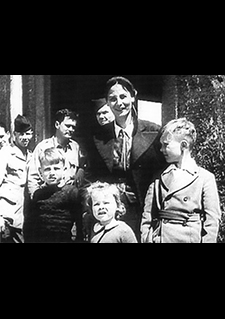“Sippenhaft” for the Family
From 1933 onward, the Nazis employed “Sippenhaft” (family liability punishment) sporadically as a repressive measure against relatives of opponents of the regime. It served to stoke fear in the populace.
“Sippenhaft” was applied especially drastically after July 20, 1944. A mass arrest of relatives of the resistance fighters was launched following a meeting of Himmler, Keitel and Hitler in the “Führer Headquarters” near Rastenburg on July 30, 1944. This included the families of the “conspirators” of July 20 as well as the families of individuals held prisoners of war by the Soviets who had undersigned the National Committee for “Free Germany’s” founding manifesto of July 13, 1943.
As of early August of 1944, Group XI of the Special Commission under SS-Sturmbannführer Karl Neuhaus was responsible for carrying out “Sippenhaft”. Over 140 individuals were interned as “Sippenhäftlinge” (detainees of family liability punishment) in July and August of 1944 alone.
Ingeborg Schröder was arrested in Neumünster on August 15, 1944 at the order of the Reich Main Security Office and taken to Kiel the following day. Her children Hans-Dietrich, Harring and Sibylle-Maria were sent to children’s homes of the National Socialist People’s Welfare in Heiligenhafen and later in Bad Segeberg. On October 6, 1944, the State Police in Kiel notified the Gestapo at the State Police in Schwerin that “family liability punishment” had been imposed on Ingeborg Schröder.
In the meantime, a trial against Johannes Schröder in absentia for treason was begun before the Reich Court Martial. A letter from the farmer August Hering from Breesen in Mecklenburg was found during a house search, which had informed Ingeborg Schröder that her husband broadcast on the National Committee for Free Germany’s radio station. August Hering was sentenced to death for listening to Radio “Free Germany”.
On October 7, 1944, Ingeborg Schröder was released from police custody to her parent’s residence in Kiel. In November, she returned to Neumünster where she remained until March 4, 1945. In order to avoid further prosecution, she followed, under duress, the advice to divorce her husband. She consequently got her children back, whom she was able to pick up from the home in Bad Segeberg at the end of December of 1944.
On February 5, 1945, the Chief of the High Command of the Armed Forces Wilhelm Keitel issued the order: The family shall be liable with assets, freedom or life for members of the armed forces who commit treason in captivity as prisoners of war and are therefore legally sentenced to death. The Reichsführer-SS and Chief of the German Police will decide on the extent of family liability in particular cases (Scheurig, p. 222).
Four weeks later, on March 8, 1945, Ingeborg Schröder, escorted an NSV sister, was brought with her children by train to Weimar. Afterward, on March 9, she was taken by SS guards to Buchenwald concentration camp where other “Sippenhäftlinge” were located.
On April 6, 1945, Ingeborg Schröder with her children in the transport of “detainees of family liability punishment and special prisoners” on the way to Dachau concentration camp arrived in Markt Schönberg where she stayed until April 16. Then, she was taken to Dachau concentration camp, the actual assembly point for both transports. More special prisoners from the concentration camps Flossenbürg and Mauthausen were assembled there.
Ultimately, 139 prisoners from seventeen European countries were transported in three transports to “special SS camp in Innsbruck” as hostages of the SS. In the rearguard area of the “Alpine Fortress”, they were supposed to serve Ernst Kaltenbrunner, Chief of Security Police and SD, SS-Obergruppenführer and Police General, as bargaining chips for negotiations with the Western Allies.
Closely guarded by an SS and SD escort detachment, the hostages traveled from Tyrol to South Tyrol where Wehrmacht soldiers under the command of Captain Wichard von Alvensleben liberated them from the control of the SS in Niederdorf im Hochpustertal on April 30, 1945. Alvensleben also took the detainees under his protection and brought them to Hotel Pragser Wildsee. The detainees were handed over to American soldiers on May 4, 1945. The Americans brought them to Capri in two transports on May 8 and 10, 1945. Ingeborg Schröder returned with her children to Neumünster on June 29.
Johannes Schröder only learned of his family’s fate after the war in captivity through a radio address by Munich Cathedral Canon Johann Neuhäusler in Vatican Radio.
Source / title
- © Reproduction German Resistance Memorial Center

